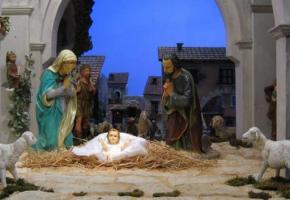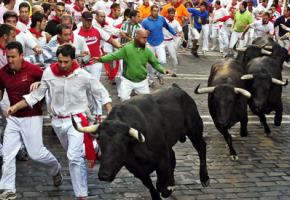A group of teenage girls are sitting on the doorstep of some apartments, the flamboyant layers of colour and ruffles and polka-dots of their flamenco dresses sprawled across the mucky concrete, laughing and making comments at passers-by in their thick Andalusian accents. The block is one of many in a maze in which drinking antics can be hidden from their parents before they make their grand entrance into the Feria de Sevilla. It has been raining for days and the embroidered edges of their dresses are soaked in rain, spilled beer and rebujito.
Bright flowers crown their heads. When they see the sun beginning to set, they throw their empty bottles of Sprite and manzanilla (the sherry from Jerez crucial for the traditional rebujito cocktail) behind them and run to the Feria in their heels.
There they meet their other friends, the boys dressed like old-fashioned caballeros, and their families, the mothers briskly patting the dirt off the back of their daughters' dresses they so laboured over making, or securing its loan from a cousin. They enter their private casetas (tent-like huts), or those of their friends or colleagues, and begin the night of eating, drinking and dancing Sevillanas.
They will be in one caseta of over a thousand that form the mini-metropolis that comes to life once a year. Roads are named after famous bullfighters, and the name of each caseta reflects its owner, which includes families, organisations such as the Port Authority, political parties and flamenco peñas. Everyone in the huts that night is doing exactly the same things; celebrating life, friendship, the beauty of Seville and its folklore music that they love. They will come back tomorrow for lunch, then again in the evening, and so on for the rest of the week.
The fun fair is busy twenty-four seven with over four- hundred activities and attractions. Zig-zagging one's way through them feels like a roller-coaster ride in itself. Men's sand-stained black shoes are falling off from the rides, and the ladies' dresses blossom out like flowers as they are twisted and turned.
The merry-go-round has real horses carrying children round in circles, which is less surprising to the eye that has witnessed some of the seven-hundred horses and carriages that arrive in the Feria each day (distinguished from the horses and carriages that transport tourists around the city by their piaffe), their passengers delighted, as well as the lone riders, sometime very young boys and girls, showing off their control.
The annual Feria, pure celebration, with its origins in 1846, is an example of the Andalusian mindset - their pride in tradition. Never something they cannot afford, the festivities of April will keep the world turning and the attendees will keep it in their memories for the rest of the year, looking forward to the next; a lingering, eternal sense of pride and excitement. Hundreds of thousands of euros are spent by the owners of the casetas, hundreds of thousands are earned by the nearby bars and restaurants. Seville looks like a film-set depicting a lost time, the Andalusian 'Gone with the Wind', for those experiencing it for the first time.
However, it would be too romantic to say that the entire city lives and breathes for the Feria and that there is true community cohesion. Dario (aged 35) is born and bred in Seville, like his parents and his parents' parents. He is not an invitado to a tent, partly due to choice. “It is elite and private and too much of a facade. Furthermore, the Sevillanas dance is the ugliest form of flamenco, in my opinion,” he says with a frown.
His Venezuelan girlfriend, Arianna, aged 30, who has been living in Seville for ten years, spends every day at the Feria, however, in her flamenco dress. These dresses are also very commonly referred to as trajes de gitana (gypsy dress). Indeed, the style comes from the dress of gypsies, who were the original soul of flamenco. Their descendants can be seen at the Feria desperately trying to sell freshly picked roses to the glamorous Sevillians and tourists and to recycle the food and material belongings that are left behind when the Feria closes. It begs the question; is this a fair Feria?
Notwithstanding the snobbery, the streets of the Feria are full of people happily dancing and drinking the night away. Inside the tent there is genuine happiness and hedonism. The dresses are water-colours of rainbows as they splash against each other and swirl around the pivots that are the dancers' locked eyes. There are tapas and cerveza galore. The live bands that are hired to play use a backing track with strings and brass despite being a six-piece of guitars, cajón, and singers. Everyone knows how to clap in time with the music and at which lyric of the verses of the Sevillana songs to begin dancing.
The official closing of the Feria is marked by a magical fireworks display at midnight at the end of the final day. The River Guadalquivir is lit up by layers and patterns of colour and light. The teenagers will wait another year for the excuse to be out all night with their friends, seven days in a row.



















